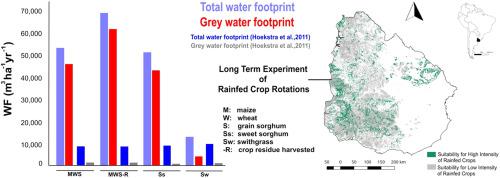Agricultural Water Management ( IF 6.7 ) Pub Date : 2021-04-05 , DOI: 10.1016/j.agwat.2021.106870 Mauricio Bustamante-Silveira , Guillermo Siri-Prieto , Leonidas Carrasco-Letelier

|
Bioenergy is the most widely used type of renewable energy. However, an assessment of water consumption and pollution is necessary to determine the water demand of this energy source. The Uruguayan public policy to decarbonize energy sources highlighted the use of bioenergy. In this regard, we analyzed the water footprint (WF) of four bioethanol cropping systems: (1) maize-wheat-sorghum rotation without harvested crop residues (MWS), (2) maize-wheat-sorghum rotation with harvested crop residues (MWS-R), (3) continuous sweet sorghum (Ss), and (4) switchgrass (Sw). In order to assess the WF of bioethanol production, green (WFgreen) and gray (WFgray) components of crop production were calculated by considering the different volumes of water involved in evaporation, rainfall, and fertilizer pollution. Annual cropping systems (i.e., MWS, MWS-R, Ss) had the largest WFs (23.1–30.9 ). Switchgrass had the lowest values per hectare and per liter of ethanol (12,735 m3(ha yr)−1 and 3.8 , respectively). The volume required to assimilate phosphorous (P) and nitrogen (N) fertilizers played a significant role in bioethanol cropping systems. In annual systems, WFgray was the main fraction (87%) of total WF (WFT). Averaged across all cropping systems, WFgray related to P was 13 times larger than WFgray related to N.
中文翻译:

乌拉圭生物乙醇种植系统的水足迹
生物能源是使用最广泛的可再生能源。但是,必须对耗水量和污染进行评估,才能确定该能源的需水量。乌拉圭的能源脱碳公共政策强调了生物能源的使用。在这方面,我们分析了四种生物乙醇种植系统的水足迹(WF):( 1)没有收获的农作物残余物(MWS)的玉米-小麦-高粱轮作,(2)有收获的农作物残余物(MWS)的玉米-小麦-高粱轮作-R),(3)连续甜高粱(Ss)和(4)柳枝((Sw)。为了评估生物乙醇生产的WF,绿色(WF绿色)和灰色(WF灰色))的农业生产要素是通过考虑蒸发,降雨和化肥污染所涉及的不同水量来计算的。年度种植系统(即MWS,MWS-R,Ss)的WF最多(23.1–30.9 )。柳枝per具有每公顷和每升乙醇最低的值(12,735 m 3(ha yr)-1和3.8 , 分别)。吸收磷(P)和氮(N)肥料所需的体积在生物乙醇种植系统中发挥了重要作用。在年度系统中,WF灰色是总WF(WF T)的主要部分(87%)。在所有种植制度平均,WF灰色有关P比WF大13倍灰色有关N.


























 京公网安备 11010802027423号
京公网安备 11010802027423号